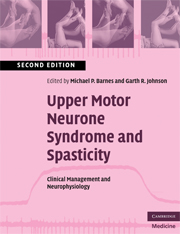Crossref Citations
This Book has been
cited by the following publications. This list is generated based on data provided by Crossref.
Keenan, Elizabeth
2010.
Spasticity management, part 3: Surgery and the use of intrathecal baclofen.
British Journal of Neuroscience Nursing,
Vol. 6,
Issue. 1,
p.
12.
Dvorak, Eric M.
McGuire, John R.
and
Nelson, Mary Elizabeth S.
2010.
Incidence and Identification of Intrathecal Baclofen Catheter Malfunction.
PM&R,
Vol. 2,
Issue. 8,
p.
751.
Sasaki, Toshiyuki
Taira, Takaomi
and
Okada, Yoshikazu
2011.
Surgical Management of Spasticity(<SPECIAL ISSUE>Recent Advances in Neuromodulation).
Japanese Journal of Neurosurgery,
Vol. 20,
Issue. 2,
p.
103.
Brzostowski, Krzysztof
Drapala, Jaroslaw
and
Swiatek, Jerzy
2011.
Knowledge-Based Intelligent System Advancements.
p.
47.
Colovic, Hristina
Dimitrijevic, Lidija
Stankovic, Ivona
Nikolic, Dejan
and
Radovic-Janosevic, Dragana
2012.
Estimation of botulinum toxin type A efficacy on spasticity and functional outcome in children with spastic cerebral palsy.
Biomedical Papers,
Vol. 156,
Issue. 1,
p.
41.
Yuminaga, Hisanori
Isaka, Michiko
Hasegawa, Osamu
Niimura, Chizuko
Lee, Hanayo
Kanei, Kazuaki
and
Nishimori, Takashi
2012.
Difference in Upper Extremity Spinal Motor Neuron Excitability and Function during Walking and Stepping in Place.
Journal of Physical Therapy Science,
Vol. 24,
Issue. 10,
p.
1033.
Sunnerhagen, Katharina S.
Olver, John
and
Francisco, Gerard E.
2013.
Assessing and treating functional impairment in poststroke spasticity.
Neurology,
Vol. 80,
Issue. 3_supplement_2,
Castano, Javier Bedoya
Hoyos Escobar, Juan David
Munoz Cardona, John Edison
and
Lopez Herrera, Jose Fernando
2014.
Shoulder flexion rehabilitation in patients with monoparesia using an exergame.
p.
1.
Lindsay, Cameron
Simpson, Julie
Ispoglou, Sissi
Sturman, Steve G
and
Pandyan, Anand D
2014.
The early use of botulinum toxin in post-stroke spasticity: study protocol for a randomised controlled trial.
Trials,
Vol. 15,
Issue. 1,
2014.
Neurorehabilitation of the Upper Limb Across the Lifespan.
p.
9.
Lee, Ryan W.
Poretti, Andrea
Cohen, Julie S.
Levey, Eric
Gwynn, Hilary
Johnston, Michael V.
Hoon, Alexander H.
and
Fatemi, Ali
2014.
A Diagnostic Approach for Cerebral Palsy in the Genomic Era.
NeuroMolecular Medicine,
Vol. 16,
Issue. 4,
p.
821.
Döderlein, Leonhard
2015.
Infantile Zerebralparese.
p.
39.
Aloraini, Saleh M.
Gäverth, Johan
Yeung, Ellen
and
MacKay-Lyons, Marilyn
2015.
Assessment of spasticity after stroke using clinical measures: a systematic review.
Disability and Rehabilitation,
Vol. 37,
Issue. 25,
p.
2313.
Fang, Chia-Ying
Hsu, Miao-Ju
Chen, Chih-Chung
Cheng, Hsin-Yi Kathy
Chou, Ching-Chieh
and
Chang, Ya-Ju
2015.
Robot-Assisted Passive Exercise for Ankle Hypertonia in Individuals with Chronic Spinal Cord Injury.
Journal of Medical and Biological Engineering,
Vol. 35,
Issue. 4,
p.
464.
Konst, Matthew J.
and
Matson, Johnny L.
2015.
Comorbid Conditions in Individuals with Intellectual Disabilities.
p.
351.
Jang, Yongjun
Park, Geun-Young
Park, Jihye
Choi, Asayeon
Kim, Soo Yeon
Boulias, Chris
Phadke, Chetan P.
Ismail, Farooq
and
Im, Sun
2016.
Survey of Botulinum Toxin Injections in Anticoagulated Patients: Korean Physiatrists' Preference in Controlling Anticoagulation Profile Prior to Intramuscular Injection.
Annals of Rehabilitation Medicine,
Vol. 40,
Issue. 2,
p.
279.
Ebbesen, Christian Laut
and
Brecht, Michael
2017.
Motor cortex — to act or not to act?.
Nature Reviews Neuroscience,
Vol. 18,
Issue. 11,
p.
694.
Eftekhar, Parvin
2017.
Clinician's Commentary on Choi et al..
Physiotherapy Canada,
Vol. 69,
Issue. 2,
p.
120.
Rahimzadeh Khiabani, Reza
Mochizuki, George
Ismail, Farooq
Boulias, Chris
Phadke, Chetan P.
and
Gage, William H.
2017.
Impact of Spasticity on Balance Control during Quiet Standing in Persons after Stroke.
Stroke Research and Treatment,
Vol. 2017,
Issue. ,
p.
1.
Bonnyaud, Celine
Gallien, Philippe
Decavel, Pierre
Marque, Philippe
Aymard, Claire
Pellas, Frédéric
Isner, Marie-Eve
Boyer, François Constant
Muller, François
Daviet, Jean-Christophe
Dehail, Patrick
Perrouin-Verbe, Brigitte
Bayle, Nicolas
Coudeyre, Emmanuel
Perennou, Dominic
Laffont, Isabelle
Ropers, Jacques
Domingo-Saidji, Nabila-Yasmine
Bensmail, Djamel
and
Roche, Nicolas
2018.
Effects of a 6-month self-rehabilitation programme in addition to botulinum toxin injections and conventional physiotherapy on limitations of patients with spastic hemiparesis following stroke (ADJU-TOX): protocol study for a randomised controlled, investigator blinded study.
BMJ Open,
Vol. 8,
Issue. 8,
p.
e020915.



